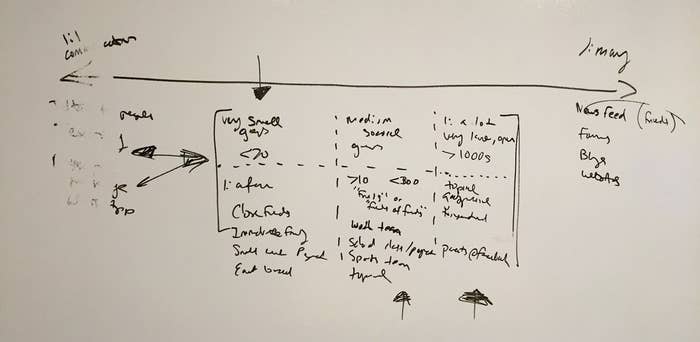
As he kicked off a discussion about his company's Groups product, Facebook product management VP Will Cathcart walked over to a whiteboard and drew a horizontal line with arrows pointing out on either end. The line, he explained, represented the spectrum of communication taking place online. On the far left: one-to-one communication, like messaging. On the far right: one-to-many, like Twitter, or Facebook's own News Feed.
The social internet has done a pretty good job facilitating communication on these two poles, with products such as messaging helping us chat one-on-one and Facebook's News Feed and Twitter's timeline helping broadcast our message to the masses. It has also somewhat faltered in the middle of that spectrum -- the "many-to-many" category -- where midsize groups ranging from book clubs to corporate organizations have largely been stuck using email as the best mode for their online interactions. But in a fundamental way, that appears to be changing.
As the internet grows, especially on mobile, the kinds of conversations it hosts mirror more and more the kinds of conversations we have in person. But there's been this one form of communication — an ongoing discussion among a group of people — that it's never really done well. Think about the kind of conversation you might have at a daily company morning meeting, or at PTA, or among a group of friends who get together every weekend to watch the Jets game. These types of conversations have been poorly served by email and forums, all the more so as the world has swapped to mobile. But that's changing with a new era of apps designed specifically to facilitate these most common kinds of conversations. It's an always-on coffee klatch, in the palm of your hand. Welcome to the era of Small Social.
"It's getting to be easy enough to move this activity online in a way that's natural for most people," said Cathcart of group interactions that occur naturally offline. "As the tools are getting easier, as people have access to things like Groups, they're starting to just do it."
Facebook, for one, is experiencing a boom in Groups membership. More than 925 million people now use the product each month — a number previously unreleased — up from 850 million just three months ago. And about 60% of Facebook's monthly active users are also Groups monthly active users, up from around 40% two years ago. It doesn't stop with Facebook. Platforms bringing midsize groups together are suddenly surging. There's also Slack, the hot chat startup that's quickly taking over the workplace. And Nextdoor, which creates mini social networks of people grouped by the neighborhoods they live in. Yammer. HipChat. The list goes on.
In a blink, one of the most common human interactions appears to be finally finding a natural home online.
"We are really pretty blown away and very, very pleased," said Nirav Tolia, CEO Of Nextdoor, of his company's progress in this environment. "Many-to-many is what we believe is the natural evolution."
Nextdoor, Tolia said, is active in 80,000 neighborhoods across the U.S., which he said is almost half the 165,000 neighborhoods in the country. Nextdoor sees over 11 million messages created on it every day, he said, and it is in over 90% of neighborhoods in the top 40 cities in the country.
Discussing the market factors responsible for Nextdoor's emergence, Tolia pointed to three: He said early social companies, namely Facebook, helped familiarize people with posting online and interacting with strangers under their real identities, making hundreds of millions of people comfortable with a behavior that could be applied elsewhere. Tolia also pointed to better mobile connectivity as something helping these platforms become more useful, as people can constantly interact on them, even when they're not in front of a computer. Finally, Tolia said so many people are now on the internet that midsize social networks have a shot at capturing the number of people needed for them to work well — instead of forcing these networks to fill in the gaps with phone calls and texts. "There are more people that you could potentially connect with than there have ever been before," he said.
What Nextdoor is for neighborhoods, Slack is becoming for the workplace. The company is quickly replacing chunks of seldom-visited intranets and cringe-inducing reply-all emails within companies using its chat platform. Slack is now used by 1.7 million people every day, up from 1.1 million in June. It is so popular, it's hit one of the tech industry's most prized success criteria: being turned into a verb. "New workplace language around @SlackHQ is finding its way into my life," wrote Stephen Wake, creative director at experience design agency Method, in a tweet. "I slack, you slack, we slacked, we've been slacking."
Stewart Butterfield, CEO of Slack, told BuzzFeed News in an email that mobile connectivity also played a big role in helping his company take off. "With the ubiquity of smartphones — which brought texting to the masses — and the rise of things like WhatsApp, WeChat, Line, Facebook Messenger, etc., there's been a huge behavioral shift to messaging as a primary means of human interaction," he said. "It suddenly feels natural to bring it into our work lives. The change is inevitable."
Facebook, of course, has long possessed a wealth of users, and Groups has been around for five years, so it's somewhat surprising to see the product experience a surge in growth now. But Groups' active user growth is outpacing Facebook's as a whole, Cathcart said. He attributed the product's success, in part, to Facebook's improved ability to get relevant groups in front of the right people via News Feed recommendations and search.
Facebook, Cathcart said, uses what's called "collaborative filtering," a recommendation system similar to Amazon's related products suggestions which suggests groups based on signals you might not find intuitive. If you're in two groups, for example, and a bunch of people who are in those groups are also in a third, Facebook might suggest you join the third even if it knows nothing about these groups' content.
There's also some good ol'-fashioned growth hacking involved. Facebook, for instance, will use its own ad inventory to promote groups to certain demographics, like study groups to students; it's added a "Create Group" option to multi-person messaging; and it will prompt people to create groups when it sees certain events — an engagement might prompt a bachelor party group, for example.
Facebook is constantly iterating on its products and then studying data to drive better results, another reason Groups is growing. When a team is ready to introduce a new tweak at Facebook, they bring their proposed new version in front of real people and ask them to talk through the experience as they use it, revealing what's surprising and what's not. When they want to introduce a new group creation workflow, for instance, the team tries to understand if the moment the user believes the new group is live matches the moment the new group is actually created. If the two don't mesh, it's back to the drawing board.
Julie Zhuo, Facebook's director of product design, described the thinking that goes into this process. "With all products, there's this funnel, where you first have to know what something is, know how it's going to help you with the problem that you have, or a thing that you want to do," she said. "Then you have to know how to create the thing, and then the thing actually has to be what you expected, it actually has to be valuable for the problem that you imagined in your mind when you set out to do this."
Groups has a pretty interesting history, too. In the early days of Facebook, people joined groups en masse as a way to display their identity on their Facebook pages, since an icon would display on their profile page announcing their group membership. This was a time when Save Darfur and Stop Facebook News Feed At Any Cost groups became wildly popular. "We saw a huge amount of joins, and everybody joined groups, but those groups had no activity," Zhuo said. Over time, though, Facebook saw conversations occurring within groups and helped them along with features such as notifications when people post. Now groups are both popular and active.
There is of course another possible explanation for the surge in popularity of Facebook Groups, Slack, Nextdoor, and others like them: The noise within the broadcast side of Cathcart's spectrum is so great that smaller networks can provide calmer, more ordered places to take refuge. Their popularity may be a reaction.
"I just would say they're different," said Cathcart, disputing this notion. There's a separate set of conversations you'd like to have with all your friends as opposed to the set you'd have with specific groups, he said.
As more midsize groups find homes on the social internet, their members will have to think about the benefits and drawbacks of moving chunks of their interactions online. For Nextdoor's Tolia, the arrow is only pointing up, as the barrier to communication lessens and more communication occurs.
"If you lower the friction that is encountered when you're trying to have an experience, well that means you're going to have more experiences. If you have more experiences, you have more interesting and important moments, and if you have more interesting and important moments, you build deeper memories. If you build deeper memories, you have a stronger connection to someone," he said.
And that, if he's right, may ultimately be the promise of the emerging social space for midsize groups online.
